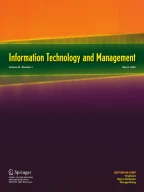Abstract
Database management systems are the primary tools of automated record keeping, reporting, auditing, and control. Although they have significantly improved the efficiency and speed of record keeping, the ability to detect errors and maintain quality has not kept pace. There are three major strategies of error detection, auditing, and control to maintain integrity. The three strategies are introduced, and compared in terms of efficiency and effectiveness in eliminating errors. The optimum timing of audits under each strategy is computed. One strategy is shown to be completely dominated by the others. Hybrid strategies involving various combinations of the three pure strategies are introduced, and their performance computed. Hybrid strategies are shown to outperform the pure strategies under most realistic conditions. Finally, optimum audit strategies are devised, and their parameters computed.
Similar content being viewed by others
References
T. Amer, A.D. Bailey and P. De, A review of the computer information systems research related to accounting and auditing, Journal of Information Systems 1 (1987) 3–28.
D.P. Ballou and H.L. Pazer, Designing information systems to optimize the accuracy-timeliness tradeoff, Information Systems Research 6 (1995) 56–82.
D.P. Ballou and H.L. Pazer, Modeling data and process quality in multi-input multi-output information systems, Management Science 31(2) (1985) 150–162.
P.A. Bernstein, V. Hadzilacos and N. Goodman, Concurrency Control and Recovery in Database Systems (Addison-Wesley, 1986).
M.J. Cerullo, General controls in computer systems, Computers and Security 4 (1985) 33–45.
E. Cinlar, Introduction to Stochastic Processes (Prentice-Hall, 1975).
R.B. Cooper, Introduction to Queuing Theory (Ceepress Books, 1990).
C.J. Date, An Introduction to Database Systems (Addison-Wesley, 1995).
G.B. Davis and R.Weber, The impact of advanced computer systems on controls and audit procedures: A theory and empirical test, Auditing: A Journal of Practice and Theory 46 (1986) 1–28.
J. Gray and A. Reuter, Transaction Processing: Concepts and Techniques (Morgan Kaufmann, 1993).
S.M. Groomer and U.S. Murthy, Continuous auditing of database applications: An embedded audit module approach, Journal of Information Systems 3 (1989) 53–69.
H.S. Koch, Auditing on-line systems: An evaluation of parallel versus continuous and intermittent simulation, Computers and Security 3 (1984) 9–19.
K.C. Laudon, Data quality and due process in large interorganizational record systems, Communications of ACM 29(1) (1986) 4–11.
W. McCune and L. Henschen, Maintaining state constraints in relational databases, Journal of ACM 36(1) (1989) 266–291.
R.C. Morey, Estimating and improving the quality of information in MIS, Communications of ACM 25(5) (1982) 337–342.
A. Motro, Integrity = validity + completeness, ACMTransactions on Database Systems 14(4) (1989) 480–502.
L.V. Orman, A model management approach to business process reengineering, Journal of MIS 15(1) (1998) 187–212.
L.V. Orman, Differential relational calculus for integrity maintenance, IEEE Transactions on Knowledge and Data Engineering 10(2) (1998) 328–341.
D.G. Paradise and W.L. Fuerst, An MIS data quality methodology based on optimal error detection, Journal of Information Systems 5(1) (1991) 48–66.
T.L. Redman, Data Quality: Management and Technology (Bantam Books, 1992).
T.L. Saaty, Elements of Queuing Theory (McGraw-Hill, 1961).
A. Segev and J.L. Zhao, Rule management in expert database systems, Management Science 40(6) (1994) 685–707.
R.Y. Wang, V.C. Storey and C.P. Firth, A framework for the analysis of data quality research, IEEE Transactions on Knowledge and Data Engineering 7(4) (1995) 623–639.
Y. Wand and R. Weber, A model of control and audit procedure change in evolving data processing systems, Journal of Accounting Research 11(3) (1989) 273–295.
R. Weber, EDP Auditing: Conceptual Foundations and Practices (Prentice-Hall, 1988).
Author information
Authors and Affiliations
Rights and permissions
About this article
Cite this article
Orman, L.V. Database audit and control strategies. Information Technology and Management 2, 27–51 (2001). https://doi.org/10.1023/A:1009930720090
Issue Date:
DOI: https://doi.org/10.1023/A:1009930720090
